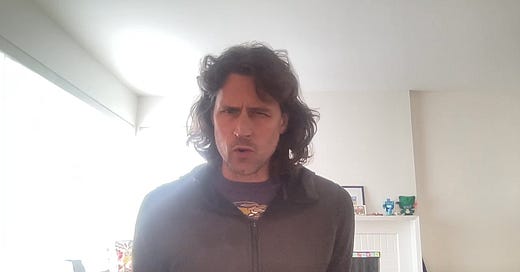Lately, I have been writing a lot for teachers. But what if you don’t have a class?
Curious what curiosity can do for you?
Sweet!
That’s why I thought I’d start a series of Curiosity-Based Thinking activities for anyone, anytime, for everyday people: parents, professionals, entrepreneurs, lifelong learners, or anyone feeling stuck, stale, or just curious about what’s possible.
In 5–10ish minutes a day, you’ll activate your inner explorer with fun, flexible Curiosity-Based Thinking activities that unlock new perspectives, spark creativity, and build mental strength.
You can think of Curiosity-Based Thinking as mental pushups to buff up your mind-muscle. And this series of activities as your personal trainer for your personal curiosity.
Because curiosity isn’t just for kids or scientists. It’s a tool anyone can use to turn mundane moments into opportunities for growth and joy.
In this series, you’ll get quick activities to try anywhere, from your morning coffee to your evening walk.
Curiosity for Self-Development: The "What If...?" Me
Take a question from The Book of What If...?, for example, "What if you had no possessions?" (p. 115).
Or let your curiosity come up with your own “What if…?” like, “What if I tried a new breakfast?” or “What if I smiled at a stranger?”
Spend 5 minutes jotting down your immediate thoughts. How would your daily routine change? What would you value most? What are you going to do next?
This simple activity helps you reframe your current perspectives and values on a daily basis.
Curiosity for Innovation: Animal-Inspired Solutions
Pick an animal from The Screaming Hairy Armadillo, like the yeti crab.
Ask, “What if I solved this problem like a yeti crab would?”
Spend five minutes brainstorming how its traits could inspire a fresh idea.
This simplifies complex issues and sparks solution-oriented thinking.
Curiosity for Leadership: Curious Team Pulse
Ask a colleague, classmate, or family member, “What’s one thing you’re curious about today?”
Listen for five minutes.
This activity leverages personal curiosity to build connection and demonstrate how curiosity drives leadership.
Curiosity for Creativity: Animal Innovation from The Screaming Hairy Armadillo
Randomly pick an animal from The Screaming Hairy Armadillo, like the "Waxy Monkey Tree Frog" (p. 129).
You might ask: "What if I approached my next [creative task/hobby] with one characteristic of this animal?"
And you might reply with something like, "What if I produced my own 'waxy coating' of protection against distractions?"
This activity encourages unconventional thinking by applying animal traits to human tasks.
Curiosity for Fitness: Curious Steps
On your next walk, ask “What if I moved like a moonrat?” (Or a different animal from The Screaming Hairy Armadillo).
Spend five minutes mimicking an animal’s gait. How long can you sustain moving like that animal?
Did you know short bursts of exercise can go a long way to getting in fitter? Could you mimic one of these animals’ movements for three bursts of 1-2 minutes during your day?
If you can, this is one way, your personal curiosity can start making your personal fitness more playful, fun, and effective!

Curiosity for Family: Shared "What If...?" Dinner Question
During a family meal, pose a "What if...?" question from The Book of What If...? like, "What if our pet could talk?” or create your own fun one, like “What if we lived on Mars?”.
Let everyone share their thoughts.
This activity turns your personal curiosity into shared curiosity that can lead to better communication, imagination, and shared fun within the family.
Curiosity for Communication: What? to Wow! Elevator Pitch
Think of something you want to explain to someone (a new idea, how you feel, a project). Quickly answer these three "What? to Wow!" questions in a single sentence each:
What? (What is it?)
Who? (Who does it affect?)
When? (When is it used/does it happen?)
Where? (Where is it used/does it happen?)
How? (How does it used//does it happen?)
Why? (Why does it matter?)
Huh? (What confuses, scares, or challenges you about it?)
Wow! (What’s the awesome and opportunity?)
This activity is a reliable way to help clarify your message and make it engaging.
Curiosity for Grit: "100 Chances" Micro-Goal
Think of a small task you've been procrastinating on. Instead of aiming to finish it, your goal is to take just one "chance" or step towards it, however tiny.
After that one step, ask yourself: "a) Something valuable I learned from this tiny step?" and "d) What's the next tiny 'chance' if I were to take it?".
This activity is designed to build help you turn personal curiosity into personal momentum by reframing big tasks into a series of manageable, curiosity-driven steps, fostering resilience through small wins.

Curiosity-Based Thinking: The Science-Backed Advantage
Curiosity is more than a quirk—it’s a powerful advantage. Studies show that curiosity:
Enhances learning and memory by increasing dopamine and reward anticipation.
Helps you tolerate ambiguity and complexity—critical for problem-solving.
Reduces defensiveness, anxiety, and stress while increasing creativity, empathy, and collaboration.
Curiosity-Based Thinking (CBT) turns this natural superpower into a daily practice. Rooted in empathy, discovery, and action, CBT gives structure to spontaneous wonder and helps you reframe the ordinary into the extraordinary.
Let’s Get Curious Together
This series is just the beginning. Every week, we’ll explore quick, clever ways to fuel your curiosity to boost your thinking, actions, and joy.
Because when you practice curiosity, you get more out of your curiosity.
Stay curious!
Matt
Oh! And Teachers, if you’re curious about those Curiosity-Based Thinking activities for the classroom, you can find some here, here, here, here, here, and here!
👉 Follow this series to receive new Curiosity-Based Thinking activities delivered weekly—each one simple, flexible, and surprisingly powerful. Whether you’re brushing your teeth or running a boardroom, curiosity belongs there.











Share this post